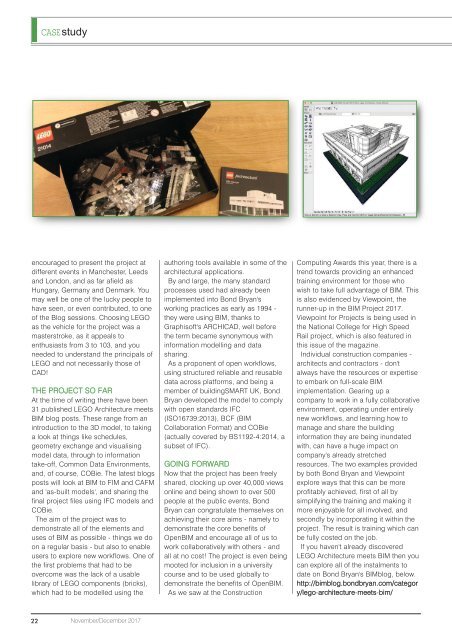You also want an ePaper? Increase the reach of your titles
YUMPU automatically turns print PDFs into web optimized ePapers that Google loves.
CASEstudy<br />
encouraged to present the project at<br />
different events in Manchester, Leeds<br />
and London, and as far afield as<br />
Hungary, Germany and Denmark. You<br />
may well be one of the lucky people to<br />
have seen, or even contributed, to one<br />
of the Blog sessions. Choosing LEGO<br />
as the vehicle for the project was a<br />
masterstroke, as it appeals to<br />
enthusiasts from 3 to 103, and you<br />
needed to understand the principals of<br />
LEGO and not necessarily those of<br />
CAD!<br />
THE PROJECT SO FAR<br />
At the time of writing there have been<br />
31 published LEGO Architecture meets<br />
BIM blog posts. These range from an<br />
introduction to the 3D model, to taking<br />
a look at things like schedules,<br />
geometry exchange and visualising<br />
model data, through to information<br />
take-off, Common Data Environments,<br />
and, of course, COBie. The latest blogs<br />
posts will look at BIM to FIM and CAFM<br />
and 'as-built models', and sharing the<br />
final project files using IFC models and<br />
COBie.<br />
The aim of the project was to<br />
demonstrate all of the elements and<br />
uses of BIM as possible - things we do<br />
on a regular basis - but also to enable<br />
users to explore new workflows. One of<br />
the first problems that had to be<br />
overcome was the lack of a usable<br />
library of LEGO components (bricks),<br />
which had to be modelled using the<br />
authoring tools available in some of the<br />
architectural applications.<br />
By and large, the many standard<br />
processes used had already been<br />
implemented into Bond Bryan's<br />
working practices as early as 1994 -<br />
they were using BIM, thanks to<br />
Graphisoft's ARCHICAD, well before<br />
the term became synonymous with<br />
information modelling and data<br />
sharing.<br />
As a proponent of open workflows,<br />
using structured reliable and reusable<br />
data across platforms, and being a<br />
member of buildingSMART UK, Bond<br />
Bryan developed the model to comply<br />
with open standards IFC<br />
(ISO16739:2013), BCF (BIM<br />
Collaboration Format) and COBie<br />
(actually covered by BS1192-4:2014, a<br />
subset of IFC).<br />
GOING FORWARD<br />
Now that the project has been freely<br />
shared, clocking up over 40,000 views<br />
online and being shown to over 500<br />
people at the public events, Bond<br />
Bryan can congratulate themselves on<br />
achieving their core aims - namely to<br />
demonstrate the core benefits of<br />
OpenBIM and encourage all of us to<br />
work collaboratively with others - and<br />
all at no cost! The project is even being<br />
mooted for inclusion in a university<br />
course and to be used globally to<br />
demonstrate the benefits of OpenBIM.<br />
As we saw at the Construction<br />
Computing Awards this year, there is a<br />
trend towards providing an enhanced<br />
training environment for those who<br />
wish to take full advantage of BIM. This<br />
is also evidenced by Viewpoint, the<br />
runner-up in the BIM Project 2017.<br />
Viewpoint for Projects is being used in<br />
the National College for High Speed<br />
Rail project, which is also featured in<br />
this issue of the magazine.<br />
Individual construction companies -<br />
architects and contractors - don't<br />
always have the resources or expertise<br />
to embark on full-scale BIM<br />
implementation. Gearing up a<br />
company to work in a fully collaborative<br />
environment, operating under entirely<br />
new workflows, and learning how to<br />
manage and share the building<br />
information they are being inundated<br />
with, can have a huge impact on<br />
company's already stretched<br />
resources. The two examples provided<br />
by both Bond Bryan and Viewpoint<br />
explore ways that this can be more<br />
profitably achieved, first of all by<br />
simplifying the training and making it<br />
more enjoyable for all involved, and<br />
secondly by incorporating it within the<br />
project. The result is training which can<br />
be fully costed on the job.<br />
If you haven't already discovered<br />
LEGO Architecture meets BIM then you<br />
can explore all of the instalments to<br />
date on Bond Bryan's BIMblog, below.<br />
http://bimblog.bondbryan.com/categor<br />
y/lego-architecture-meets-bim/<br />
22<br />
November/December 2017

















